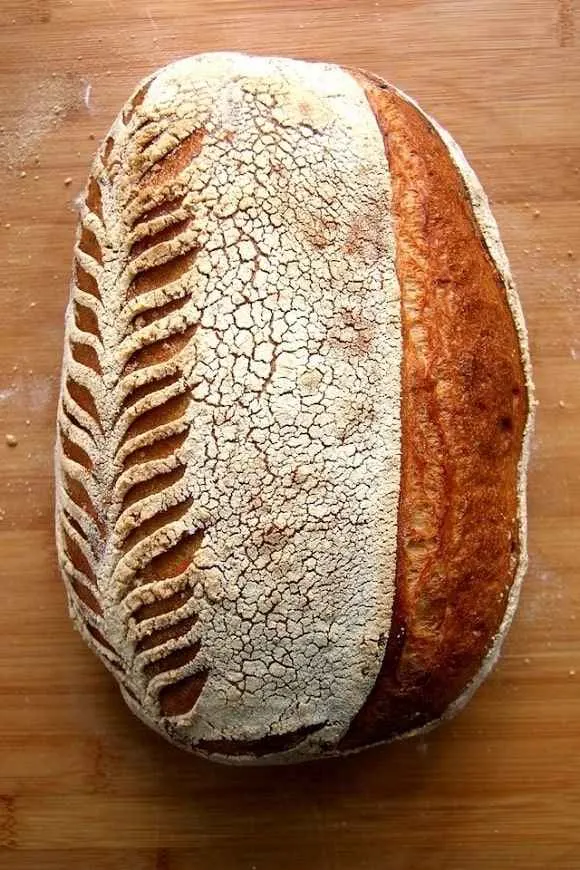We have all bought artisan bread loaves with flour on top. Some of us like it this way, while others detest it.
But is there an actual reason why bakers top their bread with flour?
One of the main reasons for bread having flour on it is so that the dough won’t stick to any surfaces during baking. Improving the bread’s esthetic value is another reason for artisan bakers to top their bread with flour.
Keep reading this article and learn everything about topping your bread with flour and why it sometimes can make a lot of sense.
Why Do You Put Flour on Bread Before Baking?

The flour on top of bread serves several purposes for both professional and hobby bakers.
They all exist to make bread different or better or to make the pre-baking process easier.
On the contrary, none of these bread-baking hacks really alter the ready-baked bread’s flavor or the dough’s texture in any way.
As such, it’s more of an add-on or a bonus that some bakers like to include in their bread-making process.
Others don’t like to put flour on their bread at all. And to be honest, most people who buy fresh bread don’t care much for it either.
I sure don’t! The often thick layer of flour on the bread loaves and baguettes I buy can be somewhat annoying, and I usually knock off most of the flour as soon as I get out of the bakery.
But there are circumstances where it makes a lot of sense to put flour on top of your bread.
The most common reasons include:
Prevents the Dough From Sticking to Surfaces

This first one is a commonly used hack that makes a lot of sense when you’re dealing with wet and sticky bread doughs.
I made a super wet dough (for airy and soft artisan bread) today, and I can tell you that handling such a sticky mess isn’t a lot of fun!
An easy way to prevent that mass is by dusting (flouring) your dough before letting it rise.
Just as putting flour on your board will prevent the dough from sticking to it when you knead it, so will dusting the dough prevent it from sticking to the bowl it rises in.
But why put flour on top, then, you ask? To prevent the dough from sticking to the cloth or plastic wrap!
Naturally, some of that flour will remain on the top of your dough when it goes in the oven, which is why you end up with that excess flour on your ready-baked bread.
Esthetic Contrasts on Artisan Breads

This next feature is essential for professional bakers of artisan bread.
Artisan, rustic bread is somewhat of an art, and art needs to be appealing to the eye if its creator wants to be able to sell it.
Simply speaking, the patterns you’re scoring or stenciling into the top of your bread will only be visible if there is a stark contrast in colors in the crust.
And that’s where the flour comes in!
Dusting the top of the loaf will create a bright, white surface and a prominent and visually appealing contrast to the dark baked crust.
The cuts you made will not be covered with the flour (as you will have made those after you topped your loaf with flour) and instead be a part of the much darker crust.

That will result in a beautifully looking artisan loaf that looks more like a painting than actual bread.
Of course, this won’t make the bread taste better, but who isn’t willing to pay a little extra for an artistic loaf of bread?
And if you bake it yourself at home, you’re guaranteed to get a lot of compliments from your family and friends when presenting and serving your artwork!
This kind of artistic bread-making has definitely become somewhat of a trend. And why not? It looks fantastic, and it’s fun to make!
Makes the Crust Crunchier

I have heard this one from many bakers and experienced it myself when baking my own bread. Flour on the top of your loaf will make the crust somewhat crunchier!
I haven’t seen any scientific proof of this, but it sure does make sense.
Flour is hygroscopic, meaning that it’ll scavenge humidity from its environment.
As the top of a loaf is a very exposed surface in the oven, and as much of the dough’s moisture will rise up and into the crust, naturally, the flour on top will extract some of that moisture.
We’re not talking about a huge difference, but I have definitely noticed a little more crunch in the crusts that had flour on them.
Makes Slashing the Loaf Easier
As previously stated, putting flour on your dough prevents it from sticking to various surfaces.
One of these is the blade of your knife or scissors, which are commonly used for scoring or slashing bread.
The flour on the loaf’s top can prevent the dough from sticking to the blade while you slash or cut through it.
I’ve encountered this problem numerous times before I decided to dust my dough.
It really makes a difference and allows you to make more precise cuts, as the dough won’t drag at all!
What Type of Flour Should You Put on Your Bread?
Can You Eat the Flour on Bread?
While raw flour can contain harmful bacteria, eating baked flour is generally considered safe.
The taste of flour on bread is a different question, of course. And I know most people do not like it. As I’ve already mentioned, I’m not a fan of dusted bread.
It just gives you a dry and powdery sensation when eating your bread, which is something I can live without.
That’s why I’ll always dust off my bread loaves, and as most of the flour on the crust won’t get baked into it, this is usually an easy and quick task.

